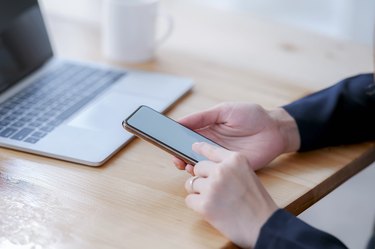
If you want to access all your iPhone's media and document files, there are desktop and mobile applications readily available to assist you -- beginning with iTunes. However, to gain root access to files on iPhone, you'd need to first jailbreak the phone. The iPhone's root directory is deliberately obscured and blocked as part of Apple's ongoing efforts to optimize app security and minimize unintended user-inflicted iPhone unreliability.
ITunes Media Files
Video of the Day
ITunes facilitates a comprehensive, if dispersed, view of your iPhone's media files. With the program running on your PC and the iPhone connected, you select the device in iTunes and examine its current content and sync sources using the tabs on iTunes' main pane. Within the File Sharing section of the Apps tab, you can further examine files stored within listed apps.
Video of the Day
Upon syncing, iTunes organizes and updates your iPhone's content in an iTunes Media folder on your PC. To locate the folder quickly, click "Edit," followed by "Preferences" and "Advanced." Navigate to the displayed iTunes Media folder location to gain access to your iPhone's audiobook, book, iTunes U, mobile app, movie, music, podcast, ringtone, TV show and voice memo files.
Cloud-Based Files
If you've enabled iCloud on your device -- or use other cloud-based repositories, such as Dropbox or OneDrive, for file storage and syncing -- you can access your iPhone files via the cloud service's website or its installed files app download process. In both cases, you need to sign in with your account ID credentials to get to your files.
Some cloud services also offer a companion desktop app that creates a directory from which to sync cloud content bi-directionally between iPhone and PC; simply use your computer's File Explorer to access the directory. You can easily download the app to use this functionality as well. It creates a simple process to access files at any time and is well worth the minute or two required to connect the cloud to the computer or iPhone.
Files App Download
With a utility app installed on both computer and iPhone, you don't have to navigate to different places on the PC or Web to access your iPhone files. The utility's desktop program presents you with an Explorer-like view of your iPhone's content -- including the hidden root files of individual apps, if desired. The utility app option is ideal when regular access to the files is a necessity.
iPhone utility apps help you manage and transfer files straightforwardly between your iPhone and computer, and with permission, they also work with your cloud accounts. File access and transfers can be achieved over a USB connection or shared WiFi network. Popular utility software combos worth exploring include DiskAid and the FileApp app, iExplorer and iExplorer Mobile app, and iFunbox and iFileExpress app.
Root Level Files
By design, iPhone users don't have access to their device's root files. However, you can jailbreak your device to gain administrative read/write root directory privileges. Jail breaking lifts all Apple-imposed iPhone constraints and frees you to shop on the Cydia app store for a capable root-file viewer.
Alternatively, you can use DiskAid and iExplorer to access the root directory of your jail broken iPhone from the desktop. Jail breaking isn't illegal, but Apple voids your iPhone warranty if it finds evidence of jail breaking on it. You can remove all such evidence with a full system restore that returns the phone to the original factory settings without showing any signs of jail breaking or access to root directory files on the device.
- Apple: Where Are My iTunes Files Located?
- The Unauthorized Guide to iPhone, iPad, and iPod Repair: A DIY Guide to Extending the Life of Your iDevices!; Timothy L. Warner
- Apple: ICloud: Creating an iCloud Account: Frequently Asked Questions
- Computerworld: Should You Risk Jailbreaking Your iPhone?
- Ole Begemann: Steve Jobs on the File System
- DiskAid: iPhone File Transfer & iOS File System
- Macroplant: IExplorer: The Ultimate iPad, iPhone and iPod Manager
- iFunBox: iFunbox: App Installer & File Manager for iPhone, iPad and iPod Touch